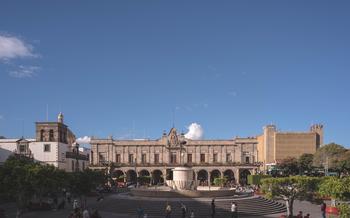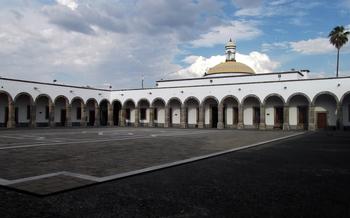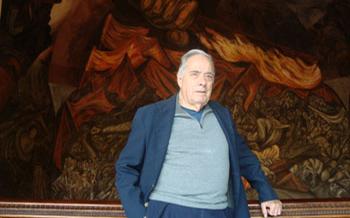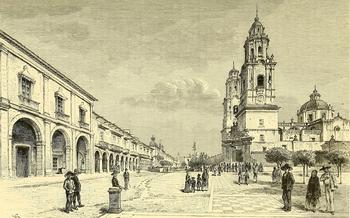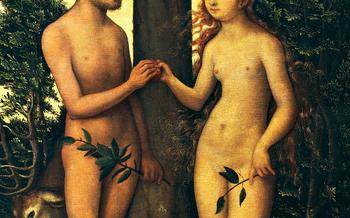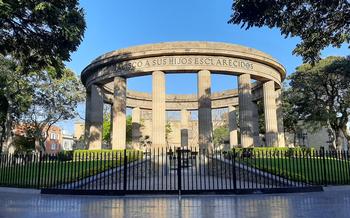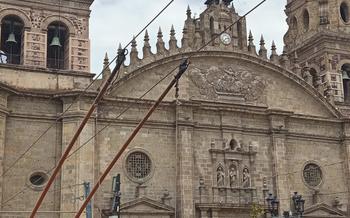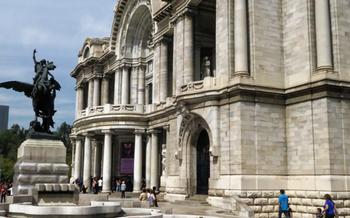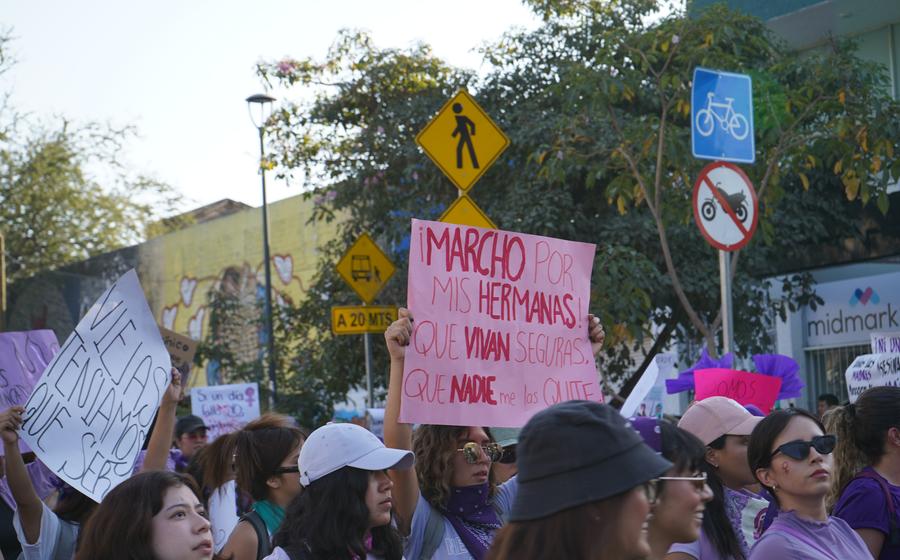
Palacio de la Cultura y Comunicación
- Palacio de la Cultura y Comunicación: An Architectural Masterpiece
- Exhibitions and Galleries: A Journey Through Art and History
- The Legacy of José Clemente Orozco: A Master's Touch
- The Grand Staircase: A Symbol of Cultural Exchange
- Interactive Workshops and Events: Engaging the Senses
- Architecture Blending Past and Present: A Modern Twist
- The Library: A Treasure Trove of Knowledge
- Guided Tours: Unveiling Secrets and Stories
- Photography and Social Media: Capturing the Essence
- Café and Dining Options: A Culinary Journey
- Transportation and Parking: Navigating the City
Palacio de la Cultura y Comunicación: An Architectural Masterpiece
Located in the heart of Guadalajara, the Palacio de la Cultura y Comunicación stands as a testament to the city's rich history and vibrant cultural scene. Constructed in the early 20th century, this architectural masterpiece blends neoclassical and art nouveau styles, creating a unique and awe-inspiring structure. Its grand facade, adorned with intricate carvings, columns, and sculptures, reflects the artistry and craftsmanship of a bygone era. As a landmark that has witnessed significant historical events, the Palacio holds a special place in the hearts of Guadalajara's residents and serves as a cultural hub for locals and visitors alike.
Exhibitions and Galleries: A Journey Through Art and History
The Palacio de la Cultura y Comunicación houses a diverse array of exhibitions and galleries, showcasing a rich blend of Mexican and international art. The permanent collection is a treasure trove of Mexican art, featuring works by renowned masters such as Diego Rivera, José Clemente Orozco, and David Alfaro Siqueiros. These masterpieces offer a glimpse into Mexico's vibrant artistic heritage and the evolution of Mexican art movements.
Temporary exhibitions delve into specific themes or showcase the works of contemporary artists, providing a platform for emerging talent and exploring new artistic perspectives. Past exhibitions have covered topics ranging from Mexican folk art to modern photography, offering visitors a chance to engage with a wide spectrum of artistic expressions.
Practical Information:
- Exhibition Schedules: The Palacio's exhibitions are typically open from Tuesday to Sunday, with varying Öffnungszeiten depending on the season.
- Fees: Admission to the exhibitions is generally free of charge, allowing visitors to enjoy the art without any financial barriers.
- Guided Tours: Guided tours of the exhibitions are available upon request, providing visitors with in-depth insights into the artworks and their historical context.
The Legacy of José Clemente Orozco: A Master's Touch
José Clemente Orozco, a renowned figure in Mexican art history, left an indelible mark on the historical narrative of Mexico.
Orozco's murals adorn the walls of the Palacio, inviting visitors to embark on a visual journey that explores themes of revolution, social justice, and the complexities of the human condition. Through his masterful use of color, form, and symbolism, Orozco brings to life historical events, cultural traditions, and poignant social commentaries.
One of the most striking murals, located in the central courtyard, depicts a powerful allegory of the Mexican Revolution. Orozco's bold brushstrokes and vibrant colors capture the chaos and turmoil of this transformative period, while also paying homage to the resilience and determination of the Mexican people.
In another mural, Orozco delves into the world of mythology and ancient Mexican traditions. Intricate figures and symbols intertwine to tell stories of creation, deities, and the interconnectedness of all living beings. Orozco's murals are not merely decorative elements; they are profound artistic expressions that provoke thought, spark conversations, and offer a deeper understanding of Mexico's rich cultural heritage.
Visiting the Palacio de la Cultura y Comunicación is an opportunity to witness the genius of José Clemente Orozco firsthand. His murals, with their powerful messages and stunning visuals, are a testament to his artistic prowess and his commitment to using art as a tool for social change and cultural expression.
The Grand Staircase: A Symbol of Cultural Exchange
The Palacio de la Cultura y Comunicación's grand staircase is a masterpiece of architectural grandeur, symbolizing the building's role as a cultural exchange hub. Its sweeping curves and intricate ironwork create a sense of awe and wonder, inviting visitors to ascend to the upper floors and explore the treasures within.
The staircase was designed by renowned Mexican architect Luis Barragán, who drew inspiration from traditional Mexican haciendas and colonial architecture. Its design incorporates elements of both Spanish and indigenous cultures, reflecting the rich cultural heritage of Guadalajara.
Historical accounts suggest that the staircase was a site of significant cultural exchange during the building's early years. Artists, intellectuals, and dignitaries from around the world would gather on the grand staircase, sharing ideas and fostering connections that shaped the cultural landscape of Guadalajara.
For visitors today, the grand staircase offers a unique opportunity to capture stunning photographs. The interplay of light and shadow, the intricate details of the ironwork, and the sweeping views of the Palacio's interior make for a truly captivating backdrop. Visitors are encouraged to take their time ascending the staircase, savoring the beauty of this architectural masterpiece and imagining the vibrant cultural exchanges that have taken place here over the centuries.
Interactive Workshops and Events: Engaging the Senses
The Palacio de la Cultura y a vibrant hub for interactive workshops and events that engage the senses and spark creativity. Designed to foster cultural exchange and community involvement, these activities offer visitors a unique and immersive experience.
From art classes and mural painting sessions to storytelling workshops and traditional dance performances, the Palacio's offerings are as diverse as its collection. Whether you're an aspiring artist, a history buff, or simply looking for a fun and educational way to spend an afternoon, you're sure to find something to capture your interest.
One of the most popular workshops is the "Mural Painting Experience," where participants get the chance to create their own mural under the guidance of experienced artists. Using traditional techniques and materials, you'll learn about the history and significance of Mexican muralism while creating your own unique masterpiece.
For those interested in exploring the world of literature, the Palacio hosts regular storytelling sessions and book readings. Local authors, poets, and storytellers share their works, offering insights into Mexican culture and traditions. These sessions are a great way to connect with the local literary scene and discover new voices.
The Palacio also hosts regular dance performances, showcasing the vibrant and diverse traditions of Mexican dance. From traditional folk dances to contemporary interpretations, these performances are a feast for the eyes and a celebration of Mexico's rich cultural heritage.
To participate in these interactive workshops and events, simply check the Palacio's website or social media pages for schedules and registration information. Fees may apply for some activities, but many are offered free of charge. So, come prepared to learn, create, and immerse yourself in the cultural tapestry of Guadalajara.
Architecture Blending Past and Present: A Modern Twist
The Palacio de la Cultura y Comunicación in Guadalajara stands as a testament to the harmonious blending of architectural styles. While its foundation and structure pay homage to the grandeur of the past, contemporary elements seamlessly intertwine, creating a fascinating juxtaposition that reflects the city's vibrant cultural identity.
The original building, constructed in the 19th century, showcases a blend of neoclassical and eclectic architectural styles. However, during its renovation in the 1990s, renowned Mexican architect Alejandro Zohn masterfully integrated modern elements that complement and enhance the building's historical charm.
Zohn's vision involved incorporating sleek glass and steel structures that contrast yet complement the Palacio's traditional facade. Expansive windows flood the interior with natural light, creating a bright and inviting ambiance. The use of modern materials and techniques has allowed for the creation of open spaces and versatile exhibition areas, adapting the Palacio to the needs of contemporary art and cultural expression.
The result is a harmonious fusion of old and new, where centuries of history are respectfully preserved while embracing the dynamism of modern architecture. The Palacio de la Cultura y Comunicación stands as a symbol of Guadalajara's ability to seamlessly blend its rich heritage with a forward-looking vision, creating a cultural space that resonates with the past, present, and future.
The Library: A Treasure Trove of Knowledge
Nestled within the walls. This treasure trove of knowledge houses an extensive collection of books, documents, and resources that span a wide range of subjects, including art, history, literature, and social sciences. As a hub for research and learning, the library attracts scholars, students, and curious minds from around the world.
The library's collection is particularly rich in materials related to Mexican art and culture. Researchers can delve into rare books, manuscripts, and periodicals that shed light on the history and evolution of Mexican artistic traditions. Additionally, the library houses a substantial collection of documents related to the life and work of José Clemente Orozco, one of Mexico's most celebrated muralists.
Beyond its impressive collection, the library also boasts a beautiful and historic setting. The reading rooms are adorned with intricate murals and stained-glass windows, creating an atmosphere that is both inspiring and conducive to study. Visitors can easily spend hours poring over books and documents, surrounded by the beauty of the Palacio's architecture.
To ensure accessibility and inclusivity, the library offers a range of services for visitors with disabilities. Staff members are trained to assist individuals with special needs, and the library is equipped with ramps, elevators, and assistive devices.
Öffnungszeiten: Monday-Friday: 9 am - 7 pm Saturday: 9 am - 5 pm Sunday: Closed
Special Collections: - Orozco Collection: Over 1,000 items related to the life and work of José Clemente Orozco. - Mexican Art Collection: Rare books, manuscripts, and periodicals on Mexican art history. - Guadalajara History Collection: Documents, photographs, and maps related to the history of Guadalajara.
Guided Tours: Unveiling Secrets and Stories
Enhance your visit to the Palacio de la Cultura y Comunicación by taking advantage of the guided tours offered. These tours, led by knowledgeable and passionate guides, provide an immersive experience that unveils the rich history, architecture, and cultural significance of this iconic landmark.
During the tour, you will gain insights into the Palacio's origins, construction, and the various functions it has served throughout its existence. The guide will lead you through the grand halls, pointing out architectural details and sharing stories about the people who have walked these halls.
One of the highlights of the tour is the exploration of José Clemente Orozco's stunning murals. The guide will provide context and interpretation of these masterpieces, helping you understand their themes, techniques, and the artist's creative process.
Guided tours are available at various times throughout the day, and reservations can be made in advance to secure your spot. Don't miss this opportunity to delve deeper into the world of the Palacio de la Cultura y Comunicación and discover its hidden treasures.
Photography and Social Media: Capturing the Essence
The Palacio de la Cultura y Comunicación is a visual feast, offering countless opportunities for photography enthusiasts to capture stunning images. With its intricate architecture, vibrant murals, and captivating exhibitions, the Palacio is a photographer's paradise. Visitors are encouraged to bring their cameras and capture the essence of this cultural landmark.
The Palacio's grand staircase, with its sweeping curves and ornate details, is a popular spot for photographs. The colorful murals by José Clemente Orozco that adorn the walls of the building provide a vibrant backdrop for artistic shots. The exhibitions, with their diverse range of artworks, offer unique opportunities for capturing unique and creative images.
To ensure the best photography experience, visitors should be aware of the Palacio's guidelines regarding photography. Flash photography is not permitted within the exhibition spaces to protect the delicate artworks. Tripods and other photography equipment may be restricted in certain areas.
For those who love sharing their travel experiences on social media, the Palacio offers plenty of opportunities to engage with others. Visitors are encouraged to tag the Palacio (@palaciodelacultura) and use the hashtag #PalaciodelaCultura to share their photos and experiences. The Palacio's social media channels showcase stunning images and behind-the-scenes glimpses, offering a vibrant community for art and culture enthusiasts.
Café and Dining Options: A Culinary Journey
Indulge in a culinary Café and Restaurant offer a delectable blend of traditional Mexican cuisine with a modern twist, tantalizing the taste buds of visitors from around the world.
The Café, nestled within the heart of the Palacio, invites you to savor aromatic coffees, freshly squeezed juices, and a selection of pastries. As you sip your beverage, bask in the ambiance of the historic surroundings, where art and gastronomy intertwine.
For a more substantial meal, the Restaurant awaits with an exquisite menu showcasing the culinary heritage of Mexico. Talented chefs blend traditional recipes with innovative techniques, creating dishes that are both authentic and contemporary. Savor the flavors of enchiladas, pozole, or cochinita pibil, all prepared with fresh, local ingredients.
Whether you seek a quick bite or a leisurely dining experience, the Palacio's Café and Restaurant promise a gastronomic journey that complements the cultural immersion offered within its walls.
Transportation and Parking: Navigating the City
Reaching the Palacio de la Cultura y Comunicación in Guadalajara is a breeze, thanks to the city's well-connected transportation network. Public transportation enthusiasts will find numerous bus stops within walking distance, providing easy access from various parts of the city. Several taxi stands are also located nearby, offering a convenient option for those who prefer a more direct ride. For those embracing the digital age, ride-sharing services like Uber and Lyft operate seamlessly in Guadalajara, ensuring a hassle-free journey to the Palacio.
Once you arrive at the Palacio, parking is a breeze. The surrounding area offers designated parking lots, providing a secure and convenient option for visitors arriving by car. Street parking is also available for those who prefer a more budget-friendly alternative. Keep an eye out for designated parking spaces and be sure to adhere to local parking regulations to avoid any inconvenience. With these transportation and parking options at your disposal, exploring the Palacio de la Cultura y Comunicación becomes a seamless and enjoyable experience.

